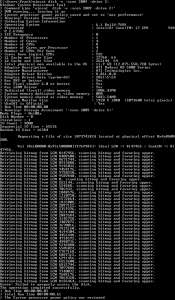I admit, it’s fancy and inspires some competition amongst the IT/development crew. But it doesn’t always work right. The Windows Experience Index (WEI) score for disk performance shouldn’t be taken too seriously, after my recent experience:
My current PC configuration includes two 40GB Intel X-25V SSD drives, one for the system and one for the programs. It’s not the highlight of the SSD world, but way faster than the usual hard disk drives.
So, happy as I was with the performance, I updated my WEI score and stared at the result: 5.9…
The details revealed, that the Primary hard disk data transfer rate component scored 5.9, the rest was over 7 (as expected).
I ensured myself that the controller was correctly set to RAID instead of IDE in the BIOS, I had the latest Intel Rapid Storage drivers installed, the Intel Rapid Storage Technology tool told me that TRIM and Disk write cache were active, and according to the suggestion of the SSD Toolbox I made sure that SuperFetch/Prefetch was deactivated. The system drive (C:) still had over 7GB of free space. Several HD benchmark tools confirmed that the SSD was still performing as fast as it should.
Still, the score stayed at 5.9.
So, here we go troubleshooting:
- I opened C:\Windows\Performance\WinSAT\winsat.log, and found this:
5451096 (0364) - winsat\main.cpp:1775: > Run Assessment disk -scen 2009 -drive C: 5451127 (0364) - storage\diskprof.cpp:2324: Unable to open temporary file. Largest available contiguous space was: 81MB
This failure also corresponded to my findings in the file C:\Windows\Performance\WinSAT\DataStore\2011-08-03 10.58.58.239
Disk.Assessment (Initial).WinSAT.xml, where I saw this:<Responsiveness Reason="UnableToAssess" Kind="Cap">TRUE </Responsiveness>
- So, I concluded that the test was trying to allocate a file bigger than 81MB in a contiguous block. Although everyone says, that SSDs don’t need to be defragmented, I performed a defragmentation with the Windows defrag tool, with the same effect on WEI, with the exception, that I now had a largest available contiguous space of 361MB. I therefore ran the disk assessment tool from the console, with the following result:
 As we can see, the tool tries to allocate a 1GB big temp file in one single contiguous block!
As we can see, the tool tries to allocate a 1GB big temp file in one single contiguous block! - Realizing that Windows Defrag doesn’t reorder my files to achieve a largest-possible block of free space, I downloaded and installed UltraDefrag, and thereby rearranged my whole SSD, so that all data was positioned at the start of the drive, and all the free space at the end.
After having executed the WEI assessment tool again, I finally saw what I wanted to see: 7.4 for drive performance.
I don’t know why the tool needs such a large contiguous block of free space, instead of coping with several small fragmented blocks (as long as there is at least 1GB of free space, which the tool seems to require). I only know that with a 40GB drive with some months serving as a system drive, it’ll be virtually impossible to preserve such a large block unallocated.
My suggestion for all users out there: If you really want some high WEI scores, I hope I could help you with my findings. Or if you’re happier with a score of 9.9, have fun.
My suggestion for the WEI team at Microsoft: Please take small and fast drives into consideration? And at least try to improve the troubleshooting experience by outputting the detailed error descriptions to a central place, preferably accessible from the WEI assessment GUI, instead of silently quitting and showing an inaccurate score. That could save so many users and admins so much time.
Just wanted to say thanks. This page helped put an end to 5 hours of pointlessly trying to meet WEI’s approval.